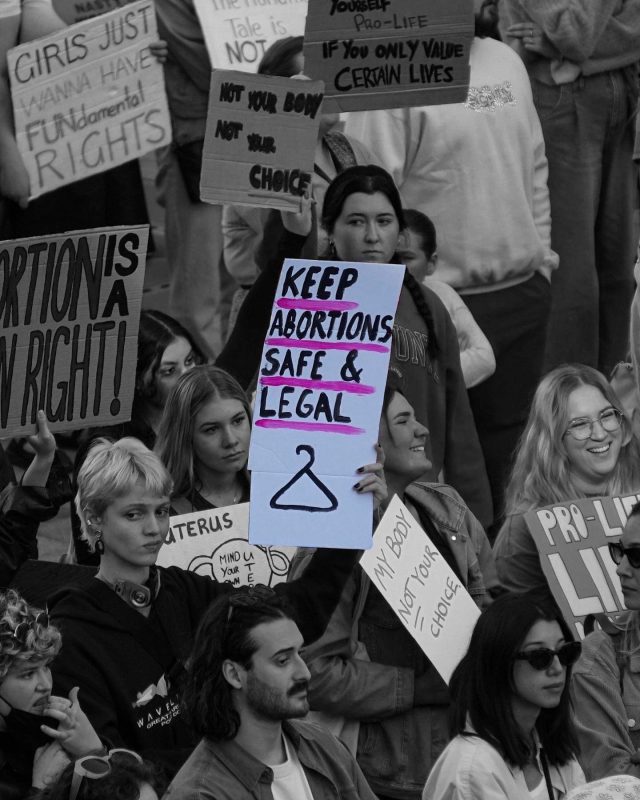Abortion is a common, essential health service. About 88,800 people have an abortion in Australia each year. Between one quarter and one third of women living in Australia will have an abortion in their lifetime.
The vast majority of Australians are broadly “pro-choice”.
A rally largely supporting the improvement of Western Australia’s abortion rules was well attended over the past weekend.

Credit Amadeus Lawson
Abortion is not a crime, but legal issues remain
In 2021, South Australia became the final jurisdiction to decriminalise abortion. However, the law has not commenced. Until then, the state’s abortion providers and patients remain subject to old, criminalising legislation. So the state government must enact the new law immediately.
Western Australia became the last jurisdiction to introduce “buffer zone” legislation, which prevents the harassment of pregnant people outside places that provide abortions. In WA, criminal law continues to regulate medical doctors who provide abortions.
All jurisdictions prohibit unqualified people from performing abortions. This is unnecessary legislation that seeks to regulate “backyard abortions”, which no longer exist, and prevents the full integration of abortion into health law (which already ensures medical procedures are performed by qualified professionals).
For the most part, however, abortion in Australia is now regulated under health law rather than criminal law. While new health laws correctly frame abortion as a matter of health, these health laws continue to impede access to it.
This is due to the continued over-regulation of abortion through measures including:
-
gestational limits to abortion (in all state/territories except the Australian Capital Territory)
-
requirements for doctors provide patients with information about counselling services (WA, NSW, SA).
Over-regulation is a direct result of, and exacerbates, abortion stigma, which treats abortion as more risky than it is in practice.
All medical procedures are already tightly regulated by government (state and federal health law), institutions (for instance, hospital policies) and professional bodies (for instance, doctors’ codes of ethics).
Removing the stand-alone abortion legislation that exists in all states/territories would treat abortion like all other health procedures and decrease abortion stigma.
Who has access? How about the cost?
People in SA and the Northern Territory can access abortion in the public system. Vulnerable people in Victoria and Tasmania also have public access.
However, abortions are costly for others because they are largely performed in private clinics rather than in the public system.
There are few abortion providers in rural and regional Australia. Currently, only about 10% of GPs are registered to prescribe mifepristone, sometimes known as RU486, for medical abortion. This figure falls to less than 1% in some regional, remote and rural areas.
We can learn from Tasmania
Since Tasmania’s last private abortion clinic closed in 2018, abortion provision in the state has been dire. Last year, the government took action, expecting that, by October 2021, select public hospitals (together, covering the entire state) would provide abortions.
Surgical abortions are now performed at three public hospitals in the state. Vulnerable women are prioritised, indicating the service may not be universal.
What would improve access around Australia?
The current shortage of abortion providers could be remedied if Australia followed Sweden to make abortion provision compulsory to the training and work of midwives and obstetrician-gynaecologists.
The federal government could tie funding for public hospitals to abortion provision.
Primary health-care provision of abortion also needs to increase, which requires two key policy shifts.
First, the Therapeutic Goods Administration (TGA) must revise its guidelines for providers and dispensers of medical abortion. At present, doctors must complete an instruction module and register to prescribe mifepristone. Pharmacies must register to dispense the drug. No other drug is subject to such unnecessary regulation.
Second, Medicare needs to add an item number specifically for the provision of medical abortion. Appointments take time and, to keep this service viable, GPs often charge an out-of-pocket fee to patients of A$200-$300. Providing a Medicare item number reflects the need for this service and would incentivise more GPs to become providers by ensuring adequate compensation.
More nurses, midwives and Aboriginal and Torres Strait Islander health workers are needed to provide abortion services if abortions are to be affordable, local and timely.
This requires several shifts, including (but not limited to) changes to state/territory abortion laws (many of which limit abortion provision to medical doctors), TGA guidelines, and increased training.
Australia’s system is not perfect
There are several legal and practical hurdles to make sure abortion in Australia is affordable, accessible, and provided in a timely manner. We can look to the recent developments in the US to mobilise, in Australia, for a health system that reflects that abortion is an essential, common part of health care that needs to remain free from stigma and political interference.![]()
Erica Millar, Senior research fellow, La Trobe University
This article is republished from The Conversation under a Creative Commons license. Read the original article.
While you are here –
PLEASE HELP US TO GROW FREMANTLE SHIPPING NEWS
FSN is a reader-supported, volunteer-assisted online magazine all about Fremantle. Thanks for helping to keep FSN keeping on!
** Don’t forget to SUBSCRIBE to receive your free copy of The Weekly Edition of the Shipping News each Friday!







